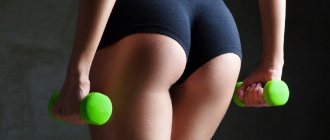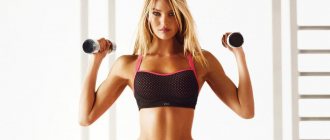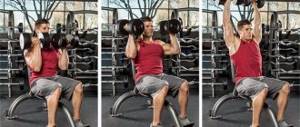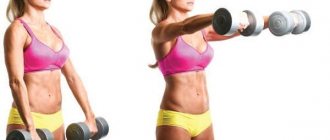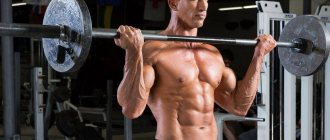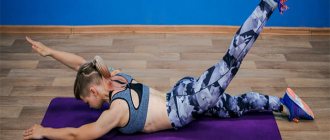A little history
Before you start doing hoop exercises for children, kids need to be interested. For example, you can tell the story of the creation of a hoop. This sports equipment was invented in America, invented by Arthur Melin. Later in Bulgaria, hoops were often used in circus art. Then circus performers began to try to twist several hoops on their bodies at once. Next, children can be invited to play as such circus performers and try to perform simple sets of exercises with a hoop with them.
Respiratory complex
Breathing exercises with a hoop can be done before and after classes, as a kind of warm-up or relaxation exercise.
- Raise the hoop up on your hands, rising on your toes, inhale, lowering, exhale.
- Place your feet shoulder-width apart, the hoop pressed to your back or chest. Leaning to the side we inhale, straightening up we exhale.
- Hoop around the body or around the chest, turn to the side - inhale, stand straight again - exhale.
- Raise the hoop above your head. We stand on our toes and, squatting, exhale, stand up and inhale.
- We hold the hoop behind our backs and bend forward, exhaling, straightening up, and inhaling.
- We put the hoop in front of us. We dive in - exhale, come back - inhale.
Benefits of exercises with a hoop
For a growing child's body, using this type of exercise will help them strengthen the core muscles of the arms, legs, back and shoulders. The hoop can also be used to stretch muscles in children, but this must be done with extreme caution so as not to harm the child.
In addition, exercises with a hoop for children help develop flexibility, strength and good coordination of movements, and if you perform these exercises to cheerful music, then also a sense of rhythm and a good mood.
How to work with a hoop correctly
Each of us has been familiar with hoops since childhood, but training with them is not so easy. The equipment requires skill and coordinated work of all muscles. To master the hula hoop technique perfectly, you need to follow a few simple steps:
- We select a projectile taking into account the characteristics of our body and our goals.
- We are looking for a comfortable place where we can study calmly, without being constrained in our movements.
Helpful advice. Ideally, there is a large mirror in the room so that you can observe the equipment during the process and immediately correct mistakes.
- Let's stand up straight. Keep your back straight, legs at shoulder level.
- We grab the hoop from both sides and “put it on” ourselves.
- We fix the pelvic area and hips, group. We make one rotational movement, pushing the hoop along the waist - we begin to twist.
- During this process, your hands can be folded into a “lock” behind your head or crossed over your chest.
- Slowly, we rhythmically make rotational movements in a circle. Lightly hold the hoop with your waist.
Beginners often fail to hold the projectile for a long time - it constantly falls, or the balance of movements is disturbed. The following recommendations may help:
- We sit down a little and push the hoop back up with our feet.
- We turn our whole body completely in the direction of movement of the sports equipment. This way it will gradually slow down and return to the right place.
- To restore rhythm and balance of movements, you can accelerate the rotational movements of the abdomen and hips.
Contraindications
There are no age restrictions for hoop classes. However, it is still better to perform exercises with a hoop for preschool children. It is at this age that the physical development of children requires increased attention, and the execution of exercises will be much better and better.
However, there are certain contraindications for hoop training. For example, if your child has any diseases of the internal organs, in particular the intestines and kidneys, then you cannot practice with a hoop. In addition, it is not recommended to perform this type of exercise for those children who have disorders in the functioning of the spine. With such children, exercises are performed under the strict supervision of specialists, for example, at exercise therapy.
Contraindications also include skin diseases, since using the hoop can further damage the skin. However, after complete recovery, children are allowed to perform exercises with a hoop.
Rules for practicing with a hoop
To perform hoop exercises for children, products made of plastic are used. They are lighter and do not cause injury to the child’s body the way a metal or aluminum hoop can.
The hoop should have a diameter of 55-65 cm, and the cross-section of the rim should be 1.5-2 cm.
Before starting the exercises, the muscles must be warmed up by performing simple warm-up exercises.
Considering that children quickly get bored with doing the same activity, it is necessary to alternate, for example, exercises with a hoop and exercises with a ball or stick.
Morning exercises
General developmental exercises with a hoop are well suited for morning exercises with a child. This will help your baby wake up, warm up his muscles before the upcoming physical activity of the day, and recharge himself in a good mood. Morning gymnastics with a hoop can be done both in kindergarten and at home individually with your child if you have the necessary equipment.
- We take the hoop by the opposite ends, stand up straight, heels together, toes apart. We perform bends. Down - exhale, put the hoop on the floor, without letting go of it. Raise the hoop up and inhale. Repeat 6-8 times at a slow pace.
- We hold the hoop in the same way, with our feet shoulder-width apart. We press the hoop to our chest, then, turning to the left, straighten our arms and exhale. We press the hoop to our chest again and take a breath. We repeat the same on the right side. Repeat 6-8 times at a slow pace.
- We hold the hoop with outstretched arms in front of us. Leaning over, we step into it first with one foot, then with the other. Once inside, lift the hoop up and remove it from yourself. We repeat the same thing. Breathing is voluntary. Repeat 6-8 times at a slow pace.
- We put the hoop on the floor and sit in it, crossing our legs. We take the hoop with both hands and lift it above ourselves, inhale, lower it and exhale. Repeat 6-8 times at a slow pace.
- Place the hoop on the floor and perform jumps in and out. In this case, you can accompany the jumps with clapping. The pace and breathing are arbitrary. After completing the exercise, you need to walk around and restore your breathing.
How to spin a hoop correctly: an effective set of exercises with a hula hoop
Before moving on to exercises with a hoop , we need to at least move it, or rather, learn how to twist it correctly. Well, let's get started learning simple steps that will help move this dead round “weight” from its place.
A simple method for beginners
Before you start spinning, take a look at your appearance. You should not wear any loose clothing, high platform shoes, bracelets or jewelry. A simple form-fitting uniform: leggings and a thick T-shirt, sports sneakers. Now you can move on to the technical part.
Step #1
Place the hoop on the floor. Choose one that reaches your chest or waist when you stand. Larger hoops are ideal for beginners - they spin slower, giving you more time to adjust to the rhythm.
Step #2
Take a step and find yourself inside the hoop (in the center).
Step #3
Squat down and grab the edges of the hoop. Place your hands at a comfortable distance from each other. You should get something similar (see image).
Step #4
Raise the hoop up to your waist. Place your feet shoulder-width apart, point your toes slightly outward, and straighten your back.
Step #5
Hold the hoop firmly with both hands. Loosen the hoop on one side of your torso.
Step #6
Spin the hoop. If you are right-handed - counterclockwise, left-handed - clockwise. All this mess will look like this (see image).
Step #7
Start making circular movements with your waist. Tighten your abs, the hoop should pass over your abdominal muscles. Press down on the hoop from behind as it moves across your back. Eventually you should find the ideal point to pump your torso.
Step #8
Continue rotating the hoop, making circular movements with your waist. Try to wrap yourself around yourself more and more evenly, evenly and evenly. If the hoop falls to the floor, try again, but now twist it in a different direction. Find your direction of rotation of the hoop.
Step #9
Please note that the hoop will fall during the first few attempts - this is normal. You must develop a sense of movement and get used to it.
Step #10
And yet he spins - enjoy!
After we have learned how to rotate the hula hoop, it's time to move on to exercises with a hula hoop, let's go. I will say right away that there are a huge number of movements, and it all depends on your imagination. We will analyze the most effective ones that will turn you into beauty queens with a wasp waist.
“Complex warm-up”
Also, as with any exercise, when working with a hoop, a general warm-up is necessary. Bring the hoop to a vertical position and grasp it with both hands. Do bends with a straight back ( 1 ). Perform 3 sets of 10 repetitions, this will make you more flexible. Another flexibility exercise: holding it with both hands, lean towards it, make turns in different directions, rolling the hula hoop ( 2 , 3 ). Perform 2 sets of 10-12 repetitions on each side.
Complex “Strong Waist”
Exercise No. 1. Alternate rotation
Rotate the hoop in different directions. Make 7-10 turns in one, then stop and do the same in the other. Change the direction of rotation about 30 times. Perform 2 approaches.
Exercise No. 2. Rotation on the go
Rotating the hoop on your waist and hips, move in small steps around the hall in the direction of the males :). Perform 2 sets of 5 minutes of “walking” each.
Exercise No. 3. Squat rotation
After spinning the hula hoop, try to squat down and rise up, maintaining the rotation. Perform 3 sets of 15 squats.
Exercise No. 4. Simple moves
While twisting the hoop, raise your arms slightly. Rotate left and right with your hips, following the direction of rotation ( 4 ). Raise your arms up and stretch (the hoop rotates, 5 ). Keeping your waist and hips tight, bring your arms together at chest level ( 6 ). Perform 3 sets of 8 repetitions of each exercise.
Complex “Wasp Waist”
While rotating the hoop, tighten your lower abdomen and lunge back alternately on both legs. Keep your back straight, actively help with your hands ( 7 , 8 , 9 ). Perform 2 sets of 15 repetitions.
By performing these simple exercises with a hoop at least 3 times a week for 15-20 minutes, your waist will decrease in size right before your eyes, and once you see yourself in the mirror, you will ask: “Who is this beauty?”
Well, that’s basically all the issues that I wanted to pay special attention to.
Exercises with hoops in kindergarten
In kindergarten, this kind of exercise is performed during physical education classes. All kinds of games and relay races can be used here, which cannot be done at home due to the lack of sufficient space.
Here are the following hoop exercises for children:
- We press the hoop to our chest and place our feet shoulder-width apart. We bend the torso to the sides. When bending over, we inhale, when straightening up, we exhale.
- We hold the hoop in our arms extended above our heads, with our feet shoulder-width apart. We rise on our tiptoes, inhale, and lower ourselves, exhale.
- Hold the hoop as in the previous exercise. We squat - exhale, rise - inhale.
- We hold the hoop behind our back, arms bent. We bend forward, straighten our arms with the hoop, and exhale. We return to the starting position - take a breath.
- "How long". We place the hoop on the floor with its rim and launch it like a spinning top, twisting it around its axis. Let go of the hoop and see who can keep it spinning longer. You need to catch the hoop before it hits the floor.
- "Catch up with him." Place the hoop as in the previous exercise. We launch him forward and try to catch up. You need to catch the hoop before it hits the floor.
- "Who is faster". We lay out the hoops on the floor. Children run or walk around the hall to the music. When the music stops, children must have time to jump into the hoop and sit down. The last child to do this is considered the loser.
Article: "Games and exercises with a hoop" article on physical education
Article:
"Games and exercises with a hoop"
The first mentions of the use of a hoop date back to the heyday of Ancient Greece, when at the dawn of its formation it was made of wooden or metal materials.
And only in the 50s of the 20th century the hoop finally acquired its modern and familiar appearance in plastic, when two large companies producing children's toys first introduced it to the world in their retail chains.
The popularity of the new product was so high that more than 25 million copies were sold in the first 2 months alone!
Despite the fact that the hoop was originally created as a toy for children, relatively quickly it began to gain authority among adults, becoming one of the most useful tools for losing weight and maintaining muscle tone.
Since that time, many sets of exercises with a hoop (or hula hoop) have been developed, which to this day are actively included in fitness classes in various areas of aerobics and choreography.
But before we proceed directly to familiarize ourselves with the list of exercises with a hoop, let’s figure out what the most beneficial benefits for the body and health of a person can be provided by such regular exercises.
The main benefits of exercises with a hoop
- Balance and coordination. To maintain continuous rotation of the hula hoop during practice, you must initially have some basic level of control of your body. Over time, you will begin to notice an improvement in the coordination of your hips and abdominal muscles, which will make it easier for you to hoop at a training pace. You can also try to spin several hula hoops at the same time, which will certainly pose new challenges for you in the development of the vestibular apparatus.
- Aerobic exercise. Today, hoops of various diameters and weights are available in sports stores. By choosing a small and lightweight option, you will be putting more energy into keeping it spinning constantly than by purchasing a heavy hoop with a larger diameter. By the way, according to experts, choosing an increased pace of work with a hula hoop will help you burn calories at the same level as running on a treadmill.
- Spinal flexibility. The process of rotating the hoop itself is an excellent exercise aimed at developing the mobility of the spinal column. This is due to the fact that during the training period the muscles of the middle and lower back are actively involved in the work. In addition, having sufficient flexibility in the spine and back significantly reduces the risk of injury during sports or any other type of physical activity.
- Core muscles (a complex of muscles responsible for stabilizing the pelvis, hips and spine). Researchers have found that when the hoop rotates, more than 30 major muscles, including the core muscles, come into play and increase their tone. The latter help maintain the human body in an even position and protect the abdominal organs and back. Plus, the deep transverse abdominal muscles, as well as the internal and external oblique muscles, middle and lower muscles are perfectly worked out, which makes hoop classes also an excellent workout for the waist.
- Mood. According to many people, regular hoop training can lift their spirits well. They are supported in this by researchers who note that properly selected physical activity not only has a positive effect on muscle groups, but also improves cerebral circulation, stimulating brain activity, which also affects the emotional state of the student.
Sets of exercises with hoop for preschoolers
Complex No. 1 (for children 3-4 years old)
Equipment: hoops with a diameter of 50 cm. Purpose: to develop small muscles of the hand, coordination of movements in small and large muscle groups, to promote the development of speed and agility. “Propeller” - hoop vertically on the floor, grip with one hand. Using a rotational movement of the hand, bring the hoop into a circular motion around its axis, catch the hoop without letting it fall. “Look through the window” - the hoop is in the same position; hold it with both hands from above. Stand on the hoop with both feet. Sit down and sway left and right, try to move forward. “Flight into space” - the hoop lies on the floor. Stand in the middle of the hoop. Sit down, take it with both hands and, standing up, lift the hoop up. Without changing the grip position, raise the hoop higher and higher to the level of your arms raised above your head. Outdoor game “Hurry up to the hoop”
Hoops are randomly placed on the floor. There are two children standing next to each one. At the signal “Run!” children run around their hoop. At the signal “Hoop!” jump into the hoop and lift it up.
Complex No. 2 (for children 4-5 years old)
Equipment hoops with a diameter of 50-70 cm. Purpose: to promote the development of dexterity, speed of reaction, attention, coordination of movements in small and large muscle groups, the ability to respond to sound signals, develop creative imagination. “On the edge of the abyss” - a hoop on the floor. Walk on the hoop with your feet straight or sideways. “Climb into the trench” - holding the hoop on top with one hand, crouch down and walk through the hoop sideways. Stand up straight and repeat again, but on the other side. “Rocket” - hoop vertically on the floor, grabbed with one hand. The child, lifting the hoop up, throws it so that the hoop does not change direction. The child tries to catch it in any convenient way.
“Catch up with the hoop” - the hoop is vertical on the floor, grabbed with one hand. At the command of an adult, children roll the hoop forward and catch up.
Outdoor game “Don’t lose the house”
There are hoops on the floor in random order (according to the number of children playing). There is a child in each hoop. At a signal, children jump out of the hoops and perform voluntary movements. Children perform various motor tasks (an adult removes one hoop). On the command “Home” the guys must quickly jump into any hoop. Anyone who does not have time to occupy the hoop receives a penalty task.
Complex No. 3 (for children 5-7 years old)
Equipment hoops with a diameter of 50-70 cm. Goal: to develop speed-strength abilities, agility, plasticity, coordination of movements in large and small muscle groups. “Twirler” - stand in the center of the hoop. Take it with both hands and lift it to waist level. Moving your torso, perform horizontal rotational movements of the hoop on your waist. “Wheel” - a hoop vertically on the floor, hold it on top with a straightened hand, push it with your hand in a given direction (the child independently chooses the option of rolling the hoop: at a distance, at a given target, with repeated pushing, etc.) “Herons” - the child places the hoop on the floor in front of him and begins to jump from hoop to hoop on one leg in different ways (straight, sideways, back), trying to stay on one leg for as long as possible.
"Mill" - a hoop on the hand. Using circular movements, rotate the hoop alternately on your right and left hand. Place your straightened arms, palms together, and untwist the hoop on both hands.

